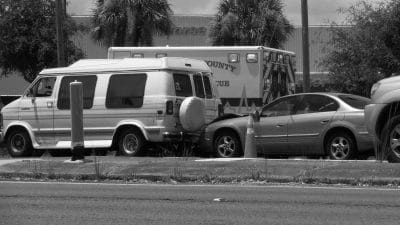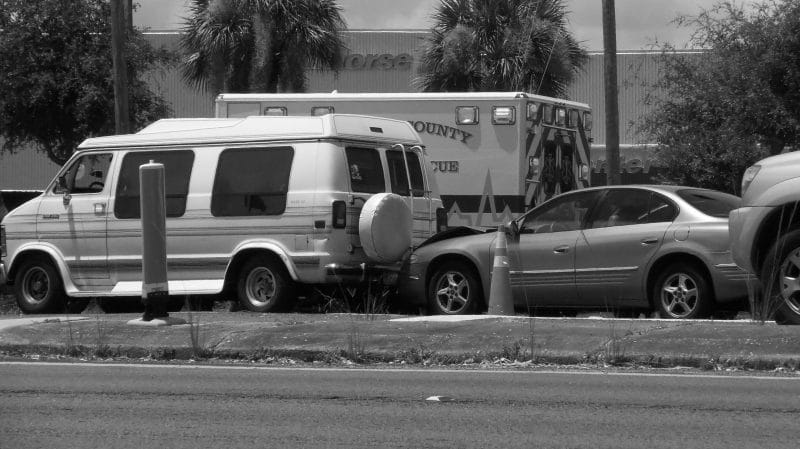
A NHTSA 2003 report defines rear end collision as a crash in which the front of one vehicle collides with the rear of another vehicle. Rear end collision is considered as one of the most frequently occurring types of crashes and is responsible for a large number of injuries, fatalities and substantial property damage annually.
The report revealed that in the year 2000, 29.7% of the total crashes were rear-end crashes. These crashes were responsible for 30% of all injuries and 29.7% of the property damage. The number of drivers who were involved in rear-end crashes were reported to be 2.2 % of 190,625,023 licensed drivers in the year 2000 alone.
You just can imagine how substantial the number would be at present considering that the number of vehicles has increased since year 2000. Additional concerns such as distracted drivers and DUI drivers may also increase the number of rear-end crashes in a year. Clearly the chance of being involved in a rear-end crash is highly probable. A driver can be extra careful while on the highway but they would be helpless and cannot control the driving behavior of those who are behind them. Additionally, when a rear-end collision occurs, the likeliness of a mutliple car pile-up is highly plausible.
Rear-end collisions often have a domino effect in a busy highway when excessive speed is involved.
A speeding vehicle that has rear-end another vehicle that has stopped for a red light, could potentially become fatal. The law of physics on inelastic collision tells that the total system momentum is conserved. The simulation shows a car (weighing 1000 kilograms) rear-ending a truck (weighing 3000 kilograms). Before the collision, the truck was not moving or parked, while the car was travelling at 20 meters per second. Because of the force of the impact, the truck was moved at 5 meters per second while the car slowed down to 5 meters per second. The car that has a momentum of 20 kg-meter per second retained only 5 kg-meters per second momentum value while the 15 kg-meter per second momentum was transferred to the truck.
Now consider it the other way around. What possibly could happen if a large vehicle rear-ended a smaller vehicle?
Moving or not, the amount of force that will be transferred to the rear-ended vehicle is surely damaging. If the driver survives the collision, injuries could be costly and life changing. Clearly, excessive speed and size of speeding vehicle that will rear-end another vehicle are something that can be considered for the expected extent of property damage and injury.
What if the speed is not substantial and the vehicle has sustained minimal damage yet the driver complains of pain?
This concern was raised by a motorist who was involved in a rear-end collision. His insurance adjuster did not believe that he has sustained any injury and he based that on the appearance of the rear-ended vehicle. It is possible that many insurance adjusters will try and convince a driver that because the vehicles sustained little or no visible damage, the vehicles’ occupants could not have been injured. This is not necessarily true. While cars are designed to handle low speed impact forces, the human body is not. Serious injuries can result from what may appear to be a minor impact. So do not take rear-end collisions lightly.
Moreover, NOLO Law identified two misconceptions regarding “whiplash”. Whiplash is the term used for a range of neck injuries that include soft tissue damage to the neck. Although whiplash injuries can result from sports, shaking, other types of car crashes (not necessary rear-ending), work related and others, it is also a common resulting injury from rear-end collisions.
NOLO stated that it is not true that whiplash-type of injuries are only caused by high speed collision.
Rather, whiplash is commonly caused by low speed, low impact rear-end vehicle collisions. The explanation provided is that the complexity of whiplash is related to other factors other than force of impact alone. When your car is rear-ended by a vehicle, there is a great probability that you were caught by surprise and so was not able to brace yourself for the impact.
The factors that will contribute to the extent of the neck injury in a low speed and low impact rear-end collisions are the following:
- position of the driver or passenger’s head at the time of impact.
- the person’s seating position.
- height, and gender of the driver.
- the position of seat and head restraints.
- the relative size and weight of the vehicles involved in the accident.
NOLO informs that “whiplash” is no longer used in court for its association to fake and exaggerated personal injury claims. The terms used instead of whiplash are:
- hyperextension
- hyperflexion injury
- myofascial injury
- neck sprain or strain
- cervical strain or sprain
The person who is involved in an accident is the best person to know if they have suffered an injury. Pain is the most common manifestation of injury and that is something that might not be visible to others. A medical check-up will confirm the cause of the pain, so a visit to the doctor is a must. And please do not ignore any pain especially after a car crash. Tell your doctor about it.
Another misconception identified by NOLO about whiplash is the idea that soft tissue injury is not serious. Medical evidence suggestd that this is not the case. In fact, untreated soft tissue injury can have a long term effects. It is recommended that immediately seeking medical attention when involved in any car accident, even if you merely sustained a scratch. Some injuries could be hidden from view.
Going back to the insurance adjuster’s unbelief, the best approach would be proper medical documentation. Seeking immediate medical attention and having proof to show to the insurance adjuster would be the best approach.
Now that we know that rear-end accidents are serious, we will consider the profile of drivers involved in rear-end crashes.
The NHTSA 2003 report titled “Driver Attributes and Rear-end Crash Involvement Propensity” also attempted to profile the age group and gender that has greater involvement in rear-end crashes. The report contains the following major findings:
- On propensity for rear-end crashes
The report claims that it made use of descriptive statistical analysis in order to determine the propensity of the drivers for rear –end crashes in the year 2000. The rates (percent frequencies) calculated with reference to the population and subpopulations of drivers indicate crash involvement profiles of drivers of different age/sex groups. Results revealed that drivers under the age of 18, have the highest propensity. The age group 18-24, ranks second in the propensity for rear-end crashes and this rank is shared by the age group 70 and above. The drivers with minimum propensity belong to 25-69 age group
- Drivers’ role in the rear-end crashes
The report also included the information on the role that drivers play in rear-end collisions. According to the NHTSA 2003 report, drivers up to the age of 25 are most likely to be the one that hits the car rather than the one one being hit.
The report also claims that as the driver grows older, there is a higher tendency to assume the striking role or that they will be more prone to rear-ending another vehicle. Young male drivers are also more of the striking role than young female drivers. This report is more on the likelihood of a driver to be involved in a rear-end collision based on age and gender. This can be used as a guide for an educational campaign or efforts to help reduce rear-end collisions.
The trends in rear-end crashes are dependent on driving behavior of all motorists. The highway is a place where accidents happen as a result of action and reaction. Distracted driving, DUI and running the red lights can add to rear-end crash statistics.
Good Guys Injury Law believes that all injured drivers are entitled to compensation to get relief from the costs of the accident. We can help you process your claim. Give us a call at (801)506-0800. If at this time you are already burdened with the hospitalization costs and may think consulting a lawyer will burden you more, do not worry the initial consultation is FREE. We also offer a “No Fee Guarantee”. This means that you will only pay our services after we won your case. In the event that we do not win your case, you have no obligation to pay us.
You may also visit our website to see the resources and testimonies of our previous clients.
Image”Rear-end collision – Car vs. Van” copyright to Daniel Oines
